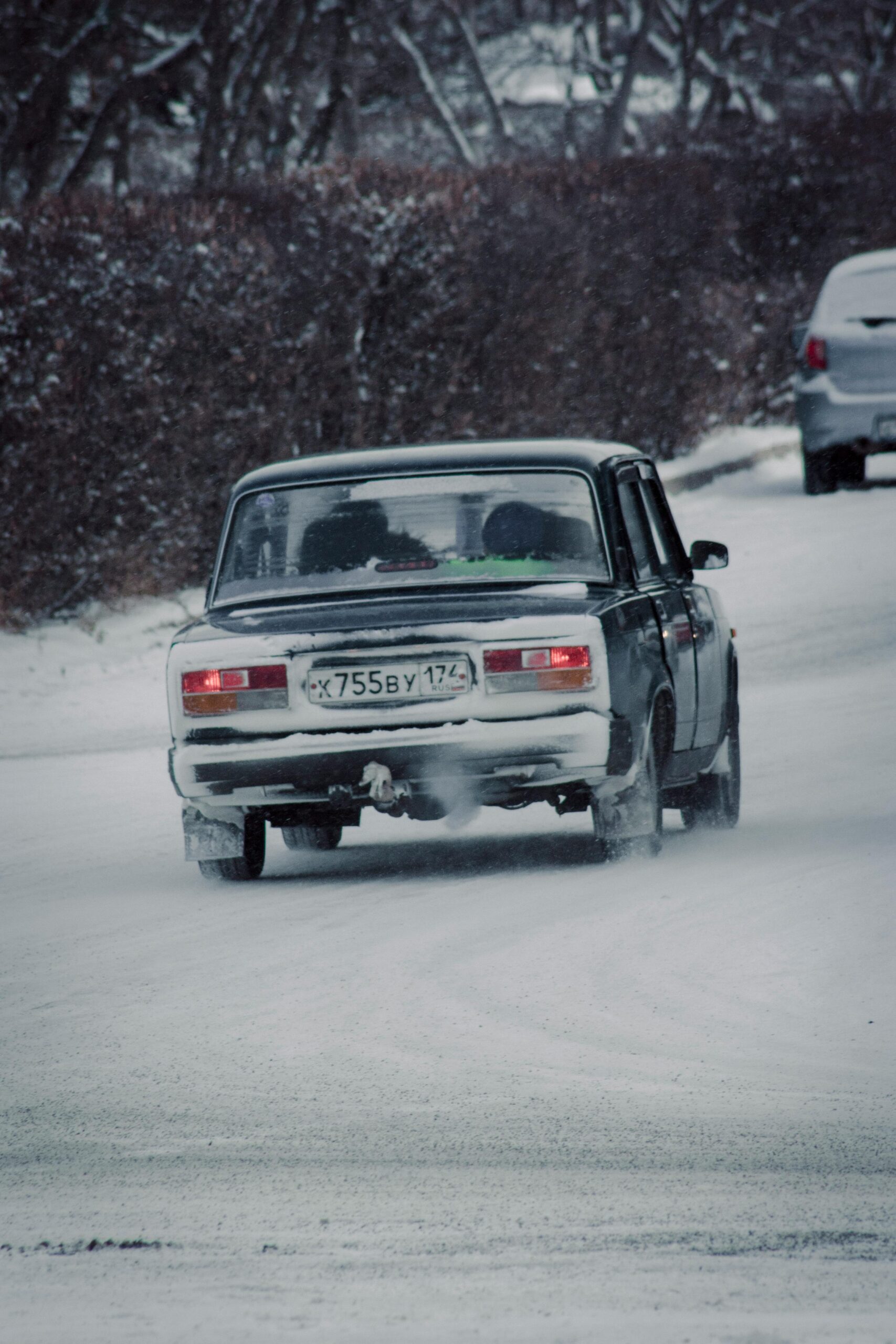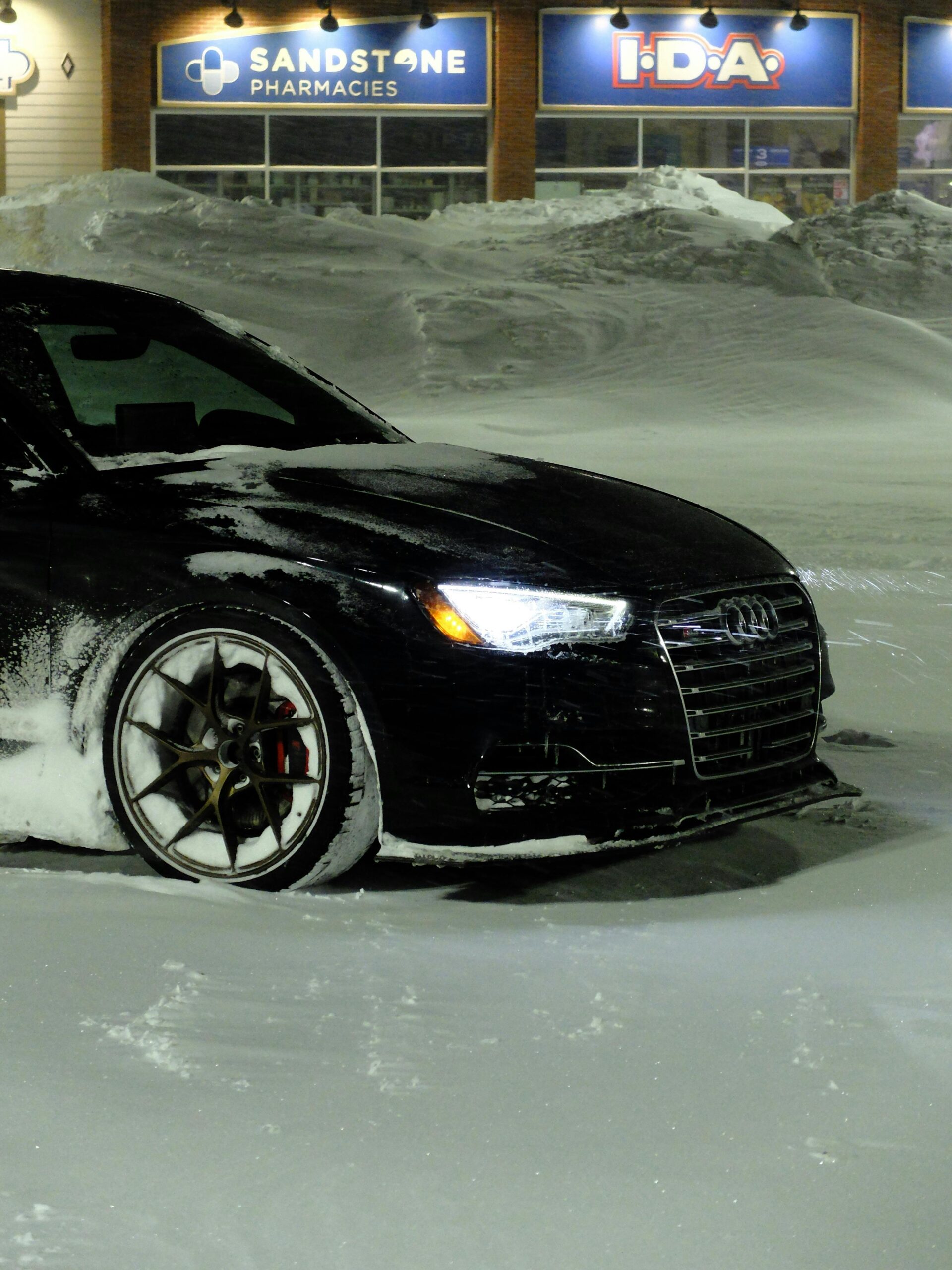These eight safe winter driving tips will help you and your fellow travelers reach your destination on icy roads!
Safe winter driving: Drive slow and steady

Driving slow and steady in winter traffic is essential to safe winter driving for several reasons. Winter roads can often be slippery due to ice, snow, or slush, and reducing your speed allows your tires to maintain better traction with the road, helping to prevent losing control. Cold and wet conditions also increase the distance needed to stop your vehicle, so driving slower gives you more time to react to any potential hazards and avoid collisions.
At a reduced and steady speed, you can maintain better control of your vehicle, especially when facing challenges like black ice, which can be difficult to detect. Driving slowly also minimizes the risk of skidding, as sudden acceleration or braking can cause your vehicle to lose traction, decreasing your chances of safe winter driving. Moreover, winter weather often brings low visibility due to snowstorms, fog, or early darkness. Slower driving allows you to spot potential dangers sooner and provides more time to react safely.
Maintaining a steady pace reduces the stress on your vehicle’s engine and tires, helping to avoid mechanical failures that can be caused by abrupt movements in cold weather. Overall, slow and steady driving in winter traffic ensures both your safety and the safety of others on the road by offering better control, more time to react, and a greater ability to handle unpredictable weather conditions.
Keep extra distance from other vehicles

Keeping an extra distance from other vehicles in winter traffic is essential for safety due to the challenging road conditions. It takes longer to stop your vehicle, even when driving at a reduced speed. By maintaining a greater following distance, you give yourself more time to react in case of sudden stops or changes in traffic flow. This added space also helps you avoid collisions if another driver loses control on icy or snow-covered roads.
Additionally, in winter conditions, your tires’ grip on the road is reduced, which can increase the risk of skidding or hydroplaning. Having extra distance allows for smoother, more gradual braking, minimizing the chances of losing control. When visibility is poor due to snow, fog, or early darkness, extra distance also gives you more time to recognize potential hazards ahead, such as stalled vehicles or accidents.
The risk of emergency situations increases during winter months. Keeping a safe distance from other cars gives you a buffer zone, reducing the likelihood of a chain reaction in the event of a collision or unexpected maneuver. Overall, keeping extra distance in winter traffic ensures you’re better prepared to handle the unpredictable challenges of cold weather driving.
Stay alert and focused

Turn on your headlights for safer winter driving

Pump the brakes or equip the anti-lock braking system (ABS)

Pumping the brakes or using the Anti-lock Braking System (ABS) is important for maintaining control of your vehicle on slippery, icy, or snow-covered roads. Winter conditions reduce tire traction, and when you brake too hard, your wheels may lock up, causing you to skid and lose control. Here’s how these techniques work:
- Pumping the Brakes: If your vehicle doesn’t have ABS, pumping the brakes gently can help you avoid skidding. By releasing and reapplying the brakes in short bursts, you allow the wheels to regain traction instead of locking up. This gives you better control over the vehicle, allowing you to steer while slowing down.
- Using ABS: ABS (Anti-lock Braking System) is designed to prevent the wheels from locking up during hard braking. When you press the brake pedal in a vehicle equipped with ABS, the system automatically pumps the brakes rapidly, maintaining traction and allowing you to steer while stopping. This reduces the risk of skidding, especially on slick surfaces like ice or snow.
Both pumping the brakes and using ABS help you maintain stability and steerability, giving you more control in emergency braking situations. Wherever roads can be unpredictable, these techniques can be the difference between staying on course or losing control. It’s important to stay calm and allow the ABS to do its job, as it will help stop the car more efficiently than pumping the brakes manually.
Keep an eye out for black ice

Black ice is a thin, transparent layer of ice that forms on the road, often blending in with the color of the asphalt, making it nearly invisible to drivers. As a result, it’s easy to drive over it without realizing, which significantly increases the risk of skidding or losing control of your vehicle.
Black ice typically forms in areas where water or moisture freezes, such as on bridges, overpasses, or shaded parts of the road. It can also form overnight or during early morning hours when temperatures are at their lowest. Because it’s so hard to spot, driving over black ice can lead to sudden and unexpected loss of traction, causing you to slide, swerve, or even crash.
Avoiding black ice involves staying alert for potential areas where it could form, reducing your speed, and maintaining a safe distance from other vehicles. If you encounter black ice, remain calm, avoid slamming the brakes, and steer in the direction you want to go.
Handle skids with ease
Easily handling skids in winter weather requires staying calm, maintaining control, and knowing the right actions to take. Winter conditions, such as icy or snow-covered roads, can cause your vehicle to lose traction. Following these steps can help you regain control quickly and safely:

- Stay Calm: The first step in handling a skid is to remain calm. Panicking can make the situation worse, leading to overcorrection or erratic movements.
- Don’t Slam on the Brakes: When you feel your vehicle start to skid, avoid slamming on the brakes. Abrupt braking can lock the wheels and worsen the skid. Instead, gently ease off the accelerator and allow your vehicle to slow down naturally.
- Steer Into the Skid: If you’re skidding, gently steer in the direction you want the front of your car to go. For example, if the back of the car is sliding to the right, turn the steering wheel to the right. This helps align the tires with the road and regain traction. Avoid jerking the wheel, as it can lead to further loss of control.
- Avoid Overcorrection: Overcorrecting by turning the steering wheel too sharply can lead to more skidding or even a spin. Make small, controlled adjustments to the steering wheel to regain control.
- Know When to Stop Trying: If you’re unable to regain control, it’s important to focus on keeping the car straight and not make sudden moves. Eventually, the vehicle may regain traction as you slow down. In some cases, the best course of action is to ease off all controls and let the car correct naturally.
By understanding these steps and practicing patience, you can handle skids more effectively in winter weather.
Never use cruise control

Cruise control is not a safe winter driving habit. Using cruise control when driving in winter weather is never a good idea because it can seriously limit your ability to react to the unpredictable conditions that are common during the colder months. Winter roads are often covered in ice, snow, or slush, and these surfaces can make driving slippery and dangerous. When you have cruise control on, your car maintains a constant speed without any input from you, meaning it won’t adjust when the road conditions suddenly change.
This lack of responsiveness can be particularly dangerous because, in winter weather, conditions can shift quickly. For example, if you suddenly hit a patch of ice or snow, your tires could lose traction. If cruise control is active, the vehicle won’t automatically slow down or adjust for the reduced grip on the road, and you might not be able to react fast enough to regain control.
Safe Winter Driving at Reston Limousine
You can always rely on our transportation company to drive you safely in the winter. We prioritize safety and preparation above all else. Our team is experienced and well-trained in handling winter driving conditions, from icy roads to snowstorms. We also ensure that our vehicles are thoroughly inspected and equipped with winter-ready features. These include high-quality tires and proper maintenance to ensure optimal performance in challenging weather conditions.
Additionally, our fleet is equipped with modern technology that enhances safety. This includes ABS, traction control, and stability systems that ensure a smooth and controlled ride, even on slippery roads. When you travel with us in the winter, you can rest assured knowing that our commitment to safety, expertise, and reliable service will get you to your destination securely, no matter the weather. Get a quote today and enjoy a special 10% off transportation through February 28th, 2025!
For more information on safe winter driving from the U.S. Department of Transportation, visit www.nhtsa.gov/winter-driving-tips.
